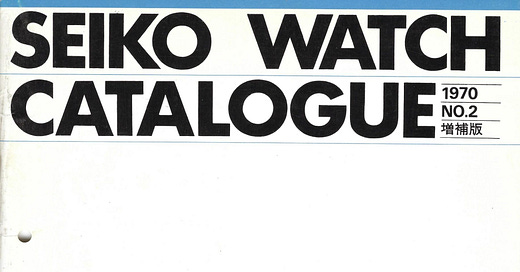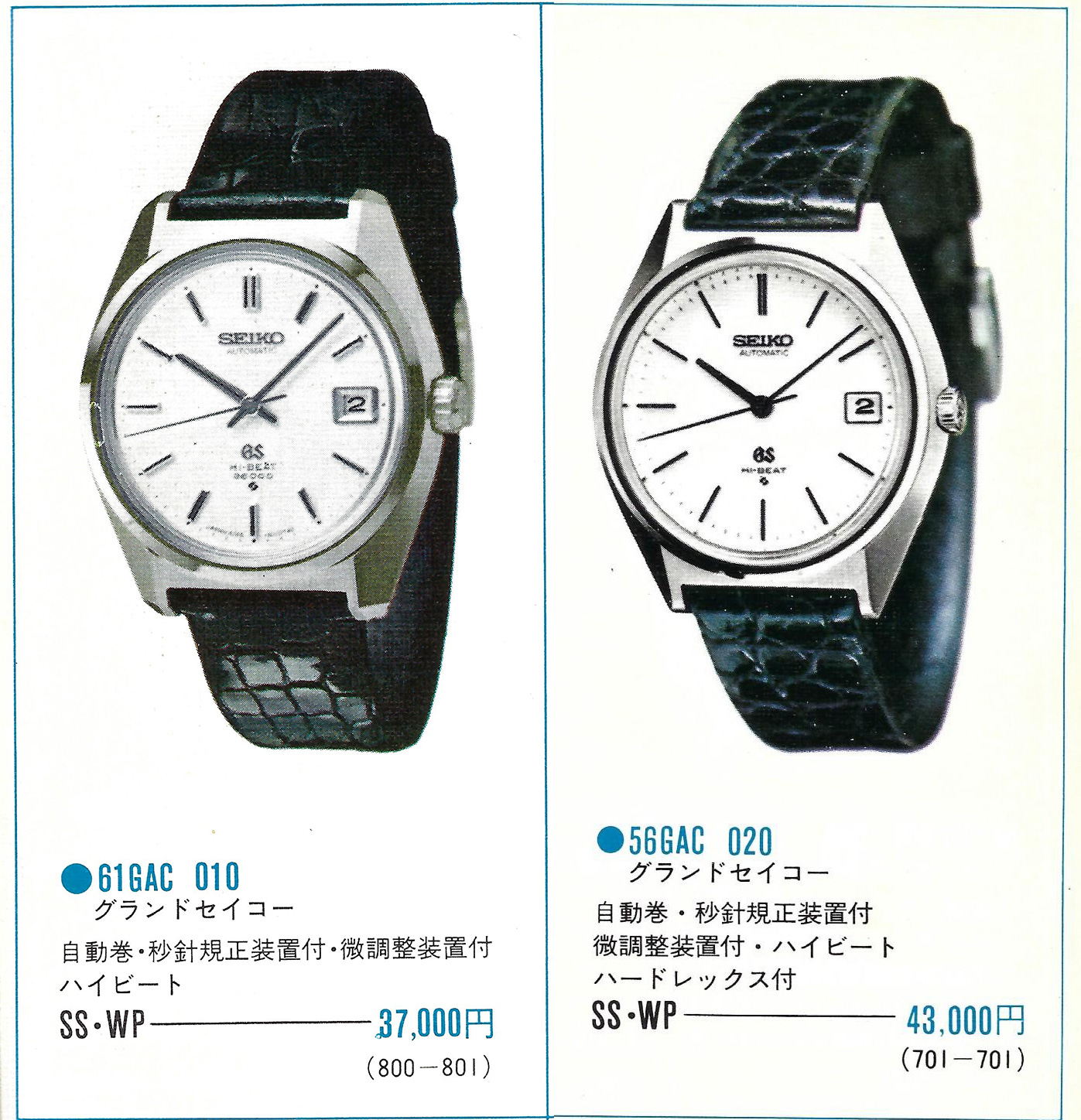Preamble
For the benefit of those subscribers who have signed up recently, each Tuesday I publish an article featuring scans of vintage Grand Seikos that appeared in the Seiko catalogues of the 1960’s and 1970’s.
Although based on the articles originally published on TGSG website, these articles will be updated where appropriate with additional knowledge gained in the three or so years since they were first made available.
Additionally, since I now have the complete set of the catalogues, I am able to publish these articles in the correct chronological order - something that wasn’t possible when posting to the main website since, when starting out documenting the catalogues, I hadn’t completed my collection of them.
You can view the previously published newsletters in this series here.
The Seiko 1970 no.2 catalogue supplement
The supplement catalogues were published to showcase just the watches added to the range following the publication of the number 2 catalogue. As such, they don’t represent the full range that was on offer, but given the timing of their publication just ahead of the holiday season, we often find them being used to debut significant new additions to the range launched just prior to the busiest sales period of the year.
The supplement to the second catalogue of 1970 is no exception, and, given that the holiday season in 1970 marked the 10th anniversary of the introduction of Grand Seiko as a brand (the first Grand Seiko had its retail launch on 18th December 1960), before we turn the page to see what it contains, it’s perhaps worth reflecting briefly on just how far Grand Seiko had come in a single decade.
In those ten short years, Grand Seiko released no fewer than thirteen calibers across six distinct series of watches (dates are given as release dates, production dates will be earlier) -
1960: “First” - 3180, 18,000 bph, manual wind, time only
1964: 57GS “Self-dater” - 430/5722A, 18,000 bph, manual wind, date complication
1966: 57GS “Self-dater” - 5722B, 19,800 bph, manual wind, date complication
1967: 62GS - 6245A/6246A, 19,800 bph, automatic wind, date complication (6245A)/day-date complication (6246A)
1967: 44GS - 4420B, 18,000 bph, manual wind, time only
1968: 61GS - 6145A/6146A, 36,000 bph, automatic wind, date complication (6145A)/day-date complication (6146A)
1968: 45GS - 4520A/4522A, 36,000 bph, manul wind, time only (4520A)/date complication (4522A)
1969: 61GS VFA - 6185A, 36,000 bph, automatic wind, date complication
1969: 45GS VFA - 4580, 36,000 bph, manual wind, time only
This catalogue debuts the seventh and final men’s vintage Grand Seiko series - the 56GS.
Grand Seiko 56GS series
The scan above shows the first four watches from the 56GS series that were introduced to the market by this catalogue. These additional four references bring the total number of men’s Grand Seiko watches offered towards the end of 1970 to 35.
The 56GS series marked a departure from the existing two series, the 61GS and the 45GS, in that unlike references from those series that had 5 Hz movements, resulting in 36,000 beats per hour, the automatic movements in the 56GS series – of which there would ultimately be three – ran at 4Hz, or 28,800 bph.
Additionally, the production process for the 56GS series involved considerably more automation that that for the earlier models. This automation, along with the lower beat rate of the movement, could well be interpreted as implying the 56GS series was in some way viewed as less superior to the 61GS series, and hence could be expected to have been a “budget” offering in the overall range.
Interestingly however, this was not the case.
The composite above shows the 6145-8000 from volume 2 of 1970’s catalogue, alongside the 5645-7010 from the supplement to that catalogue. As can be seen from the pricing, the seemingly “lower specification” 56GS references is actually 6,000 Yen (or 16%) more expensive.
I have to admit I find this pricing policy somewhat challenging. Whilst both watches of course meet the Grand Seiko Inspection Standard, it would seem logical to assume that the more manual labour intensive process of manufacturing the 61GS series compared to the (reported) highly automated production of the 56GS series would mean the former would be more expensive to produce. Additionally, as can be observed in the following comparison, the case of the 6145-8000 has a more complex design and execution.
Case profile comparison of Grand Seiko 5645-7010 (on top) and 6145-8000 (on bottom)
Where the 56GS series references do arguably score some points over the 61GS series watches is that their slimmer movements result in watches that sit slightly closer to the wrist. As can be seen from the above shots, the case back of the 6145-8000 is deeper than that of the 5645-7010, leading to the lugs sitting up higher from the table.
The 5645-7010 case is in fact almost exactly 1mm smaller than that of the 6145-8000 in all dimensions. Lug-to-lug, it is 41mm as opposed to 42mm, and the diameter is 36mm as opposed to 37mm.
One can only assume that the public at the time concurred that a slimmer profile along with more automated production more than compensated for the drop in beat rate of the movement, because there is no doubt that this reference was a huge success – it is probably the most commonly found vintage Grand Seiko in the market today.
Two movements, two cases
The four references introduced in this catalogue feature two different movements, and two different cases.
The movements were the date-only 5645, and the day-date 5646. One benefit of the day-date movement over its 6146 counterpart is that the 56GS series caliber’s day and date could both be quick-set without stopping the watch, by pulling out the crown to the first position. On the 6146 movements, only the date can be quickset – the only way to change the day was by pulling the crown out two stops, thus stopping the watch, and then changing the time 24 hours for each day that needed to be fast forwarded through.
As can be seen in the above photo, and the earlier profile comparisons, the 5645/6-7010 case is very similar to the “Grammar of Design” influenced cases found on the earlier base 44GS, 45GS, and 61GS references.
The textual information on the dial also follows the same layout that was finally established (after a protracted journey!) with the range presented in 1969’s volume 1 catalogue. The Seiko logo appears on the top half of the dial, with “Automatic” beneath it where appropriate, and in the lower half of the dial we have the Grand Seiko logo, followed by the Hi-Beat text and the Suwa factory logo. The only difference with the 56GS series compared to the final dial layouts for the 45GS and base 61GS references is of course that the latter two also have “36,000” on their dials to highlight their 5Hz movements.
The second case design presented in the catalogue is that found on the 5645- and 5646-7000 references.
A very similar brushed steel turtle-shaped case was seen on the 4520/2-7010 references introduced in the immediately preceding catalogue. At first glance, it is easy to assume that the cases are identical, but if you examine them carefully – particularly the section of the case between the lugs, differences do become apparent.
Also worth noting is the substantially larger crown found on the manual winding 45GS reference. And yes – even allowing for the fact that we are comparing a manually wound watch with one featuring an automatic movement, I do again have a lot of difficulty reconciling the price differential here.
The introduction of references in new 56GS series did not mean that we are coming to the end of the 61GS series watches – far from it. In fact, new 61GS references would be continually introduced to the range right through until 1974.
And of course, neither did it mean we are seeing the end of the 45GS manual watches from Daini.
Up next is the final – very “special” – catalogue from 1970, featuring the sole catalogue appearance of what is without doubt, quite simply the greatest vintage Grand Seiko of them all.
There is so much more to come! See you next time…










